- Home
- Painting Butterflies
Confidently Start Painting Butterflies with This Easy Watercolor Tutorial
Enjoy painting butterflies step-by-step using watercolor.
These beautiful white butterflies with prominent black veins are residents in the United Kingdom. Their name denotes their appearance, Black-veined White Butterflies.
Using my artistic license they are painted on purple thistle flowers that are common in the United States. The butterflies here like thistle flowers, so hopefully the Black-veined White Butterflies would like them, too.
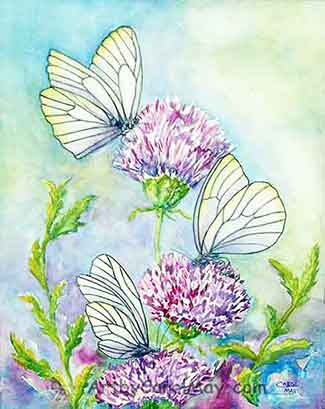 Black-veined Butterflies
Black-veined Butterflies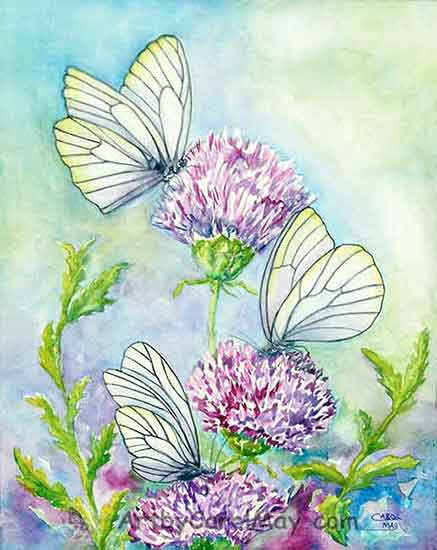 Black-veined Butterflies
Black-veined ButterfliesGet Ready for Painting Butterflies
Get your supplies ready and transfer a drawing to your painting surface.
What Do You Paint Watercolor On?
Watercolor may be done on watercolor paper, watercolor canvas or Aquabord.
My preference is Claybord or Aquabord. This butterfly painting is on Aquabord made by Ampersand.
What Colors Will You Use?
I used tube watercolor paints for painting butterflies.
- New Gamboge Yellow (A warm yellow)
- Phthalocyanine Blue (called Thalo Blue for short)
- Quinacridone Violet (A reddish violet)
- Dioxazine Purple / Ultramarine Violet (A bluish violet)
Mix your greens from the blue and yellow and use purple to darken the greens when necessary.
Draw the Butterflies
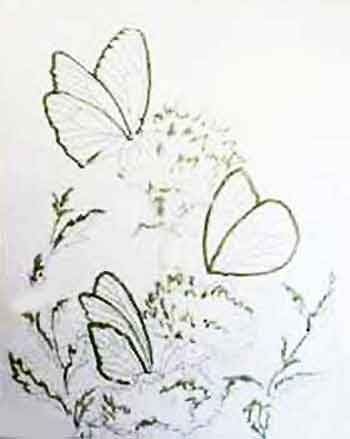 Apply masking fluid
Apply masking fluidLightly pencil a drawing on the painting surface.
Apply art masking fluid around the butterflies to keep them white.
Use a separate brush for the masking fluid.
Don't use your watercolor brushes for applying the masking fluid. If it stays in the brush very long, it is very hard to get out.
Also, put some masking on the flowers and leaves in places for highlights.
After applying the frisket, wash the brush thoroughly with some dish detergent.
Start Painting with the Background
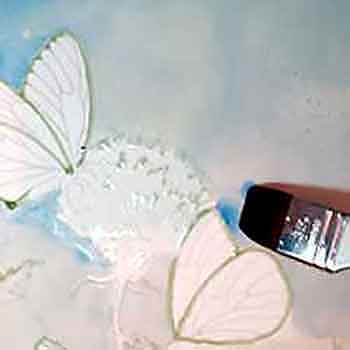 Paint the background.
Paint the background.The light in this painting is coming from the top left.
Lay in Thalo Blue with a soft wash brush.
Make the upper left background darker.
The upper background color gets lighter, as you go to the right side of the painting away from the light source.
This is caused by reflected light.
You may add a bit of yellow on the right side for the warmth of the reflected light.
Painting the Flowers
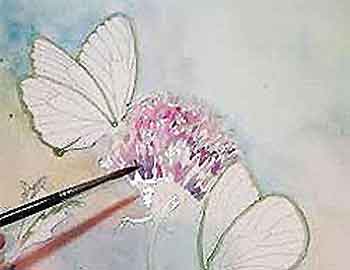 Paint the flowers
Paint the flowersbefore the butterflies
We paint the flowers before the butterflies because their bodies and legs go over the flowers.
Use a small round brush to roughly lay in the flower colors.
Don't try to paint individual petals.
Use the warmer, reddish violet on the left side of the flower which is towards the light.
Use the bluish violet on the bottom and the right side of the flower away from the light.
Let the colors flow together.
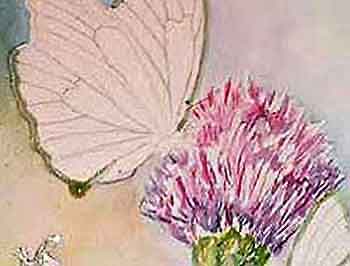 Paint extra petals after
Paint extra petals afterremoving the masking fluid.
Vary the intensity of the colors by using more or less water.
After the flower color is dry, remove the masking fluid from the flower.
Now paint some individual petals with a small round brush.
Use variations of light and dark violets.
Leave white spaces for sparkle.
The Green Parts of the Flowers
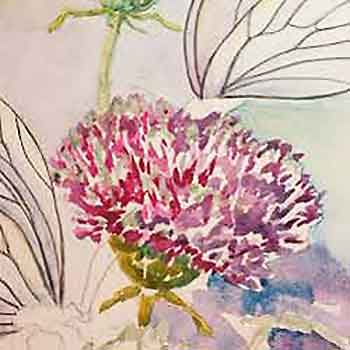 Paint the green flower parts.
Paint the green flower parts.Mix blue and yellow on your palette for your green to paint the calyx, sepals and stems.
Mix the green lighter for the side toward the light (add more yellow).
Mix the green darker for the side away from the light (add more blue).
Notice the calyx color is darker on the bottom side which is shadowed.
Add a tiny bit of blue under the edge of the petals for a shadow.
The Leaves
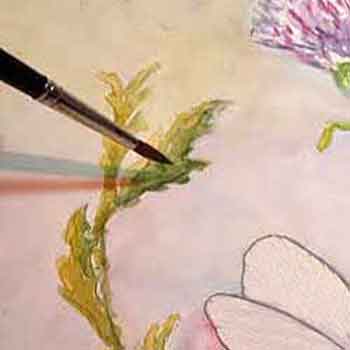 Paint the leaves with variety
Paint the leaves with varietyYou may want to paint the leaves in more detail.
I saved my detail for the butterflies and the flowers.
Mix dark and light greens the way you did for the green parts of the flowers.
Paint the leaves with a variety of light and dark greens.
The leaves toward the light will have more yellow.
Paint the shadow side of the leaves and stems a darker green, mixed with more blue.
Now We Get to Start Painting Butterflies!
Remove the Masking
Remove the masking from the butterfly wings.
You may use a dry finger to rub off the masking.
The masking is rubber cement and it easily comes off.
Or use a Pick-Up Rubber Cement Eraser, as in the photo.
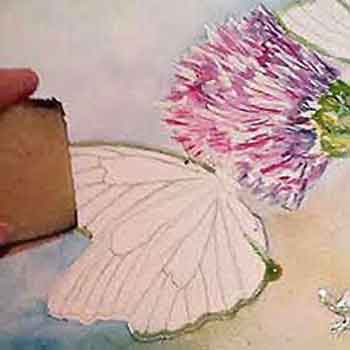 Remove the masking
Remove the maskingButterfly Wings
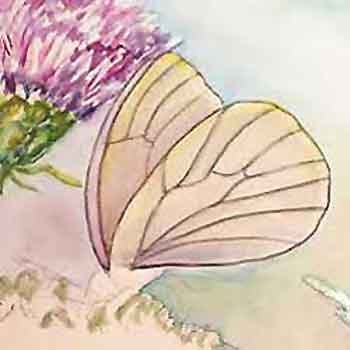 Shade the wings
Shade the wingsWhen you are painting butterflies: Keep in mind that butterflies actually have four wings.
Shade the butterfly's wings before painting the veins.
Mix lavender grey with yellow and red-violet.
Paint the grey where the
wings overlap and where they attach to the body.
Put yellow
on the top outer edges of the wings.
The warm yellow brings bottom wing forward of the lavender grey wing behind it.
Paint the Veins
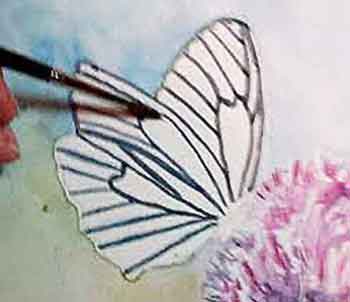 Paint the veins with a small brush
Paint the veins with a small brushMix a black by using the yellow, bluish violet and blue and paint the veins.
You may use any small, round brush or even a liner brush for the veins.
If you make a wiggle-wobble or fat veins, use a damp brush to pick up the extra paint before it dries.
I forgot to shade the wings before painting veins. So after the veins dried, I went back and did the shading.
Paint the Butterfly Bodies
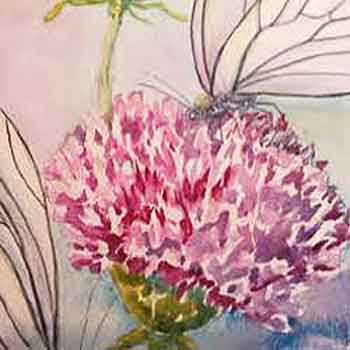 Paint the butterfly's body
Paint the butterfly's bodyButterflies have three body parts.
They have a head with two antenna, a thorax with six legs and four wings attached to the thorax and an abdomen.
Lighten the same color you mixed for the veins with a bit more water.
The body will be lighter toward the light source.
The butterfly's legs go out over the flower petals because the butterfly is standing on the flower.
Final Adjustments
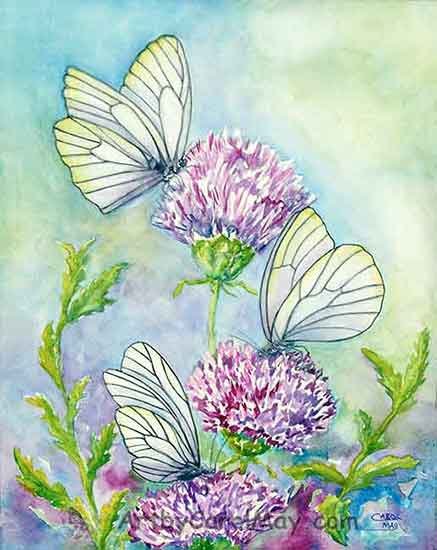 Complete Your Painting
Complete Your PaintingLook around your butterfly painting and see what you might want to touch up.
Values are what really make a painting sparkle!
You may add more darks at this time, if you feel the painting needs it.
Do it whatever suits your taste. You have an artist's license for painting butterflies.
No
two paintings will ever look the same. Every painting is an individual.
Every individual artist will do their paintings in their own manner.







 Are you eager to learn how to oil paint? What are the essential supplies for oil painting? What do we need for clean-up and how long do oil paintings take to dry? Learn the rules of oil painting and t…
Are you eager to learn how to oil paint? What are the essential supplies for oil painting? What do we need for clean-up and how long do oil paintings take to dry? Learn the rules of oil painting and t…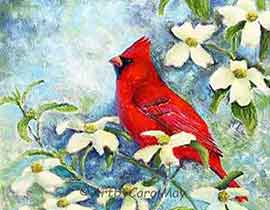 How do we create a focal point in art? Where do we put the focal point? How do we find the focus of an artwork? Should all paintings have a center of interest or can they have more than one? Learn fro…
How do we create a focal point in art? Where do we put the focal point? How do we find the focus of an artwork? Should all paintings have a center of interest or can they have more than one? Learn fro…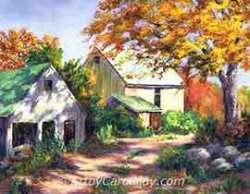 Art elements and principles appear over and over in good paintings. The elements and principles work together for us to create successful artwork. Art principles are the rules that govern how an artis…
Art elements and principles appear over and over in good paintings. The elements and principles work together for us to create successful artwork. Art principles are the rules that govern how an artis…